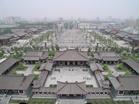|
 The major north western city of Xi'an in Shanxi Province
in China bridges the Muslim west with the Chinese administrations
to the east. Xi'an, meaning "western peace", has a vibrant
Muslim quarter within the old city walls, and also contains
many relics of its periods as capital of China. With
important archaeological sites such as the Terracotta
Warriors, Xi'an brings in many short-term tourists.
The rich culture of Shanxi Province and excellent education
will however make you want to stay longer. The major north western city of Xi'an in Shanxi Province
in China bridges the Muslim west with the Chinese administrations
to the east. Xi'an, meaning "western peace", has a vibrant
Muslim quarter within the old city walls, and also contains
many relics of its periods as capital of China. With
important archaeological sites such as the Terracotta
Warriors, Xi'an brings in many short-term tourists.
The rich culture of Shanxi Province and excellent education
will however make you want to stay longer.
 With a population of more than 7 million, Xi'an has
become a busy modern city, despite its strong links with
the past. Built on a flood plain created by the eight
surrounding rivers, Xi'an is a city built on a grid system
making it easy to find your way around the center. The
universities are mainly located to the south and east
of the city walls, with the main ancient sites within
the walls and to the north of the old city. Although
most Xi'an people are Han Chinese, Muslims have a long
history in the city, home to the Great Mosque of Xian.
To escape the plains of the city, plan a trip to the
Taoist mountain of Hua Shan, 100 kilometers to the east. With a population of more than 7 million, Xi'an has
become a busy modern city, despite its strong links with
the past. Built on a flood plain created by the eight
surrounding rivers, Xi'an is a city built on a grid system
making it easy to find your way around the center. The
universities are mainly located to the south and east
of the city walls, with the main ancient sites within
the walls and to the north of the old city. Although
most Xi'an people are Han Chinese, Muslims have a long
history in the city, home to the Great Mosque of Xian.
To escape the plains of the city, plan a trip to the
Taoist mountain of Hua Shan, 100 kilometers to the east.
Since 1990s, as part of the economic
revival of interior China, especially the central
and northwest regions, in addition to a history of
manufacturing and solid industrial establishments,
Xi'an has become an important cultural, industrial
and educational center.Xi'an has also consistently
received one of the largest foreign
direct investment amounts among cities in western
China. As much as 97% of the industries in Xi'an is
manufacturing based. Xi'an is now famous for its software
park and it is the largest aviation manufacturing center
in Asia.
As one of the most important cities in Chinese
history, Xi'an is one of the Four
Great Ancient Capitals of China. Xi'an is also renowned
for being the eastern terminus of the Silk
Road and the location of the Terracotta
Army from the Qin
Dynasty. More than 3000 years old, in ancient times
the city was called Chang'an, meaning long peace. The
Silk Road, which started in Xi'an, was taken by traders
exchanging the treasures of China with those of Europe.
Xi'an has seen exchange to the east as well. During
the Tang Dynasty, Japanese scholars studied in Xi'an
and took the Chinese script and Buddhist philosophy back
home with them.
Xi'an is known as one of the academic centers
in China. The number of institutions is
the third only after Beijing and Shanghai.
Enjoy the atmosphere, as thousands of students create
their own social life in the streets and restaurants
around the many university campuses. International students
in Xi'an are attracted to the high academic quality of
courses at the top universities, as well as to the cultural
footprints of hundreds of years of Chinese history.
| Xi'an Jiaotong University |
Xi'an Jiaotong University is a key university directed
by the Ministry of Education of China. It is one of
the oldest universities in China with her predecessor
Nanyang College founded in Shanghai in 1896. It was
given the name Jiaotong, or "Communications" University
in 1921. Xi'an Jiaotong University is a comprehensive
university with engineering science as its main focus.
More than 420 foreign students, from 23 countries, have
studied at Xi'an Jiaotong so far.
|